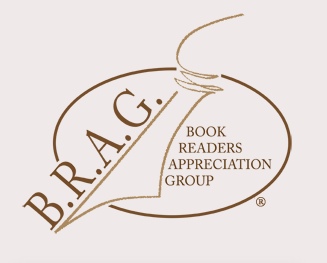The most frequent question readers have asked me since the launch of INCEPTIO in March has been: how did you work out the characters?
Karen/Carina has been buzzing around in my head for a while – about fifteen years. So in the end it was a choice between seeing a psychiatrist or becoming a writer!
 Could this be a version of Karen? Is it all about looks?
People have asked me what the characters look like. I think that’s for the reader to decide; reading is a two-way experience and my idea of what they look like could be miles away from somebody else’s.
Fiction writers often use a photo in a magazine, an actor, a painting or somebody on television to keep the character as a human being, and avoid developing a distorted cartoon or cardboard construct.
I give a few details of each person when they first appear on the pages, so that you know whether they are tall/short, young/old, what their hair and eye colour and build are. After that, you’re on your own! That’s the joy of reading a book – you can create your own world.
Knowing your character
I wrote a sketch of Karen as she was at the beginning of INCEPTIO: her basic life conditions, background, work, friends, hobbies, character traits and general attitude to life. I learned this technique at an Arvon Foundation course for commercial fiction writers and it’s stood me in good stead ever since. I added a few notes as I progressed with her story.
So, who is Karen?
 She works in a ‘run of the mill’ office job, she left education after high school and doesn’t earn quite enough money to cover her bills. She’s outdoorsy – she jogs and goes to the gym. She remembers her rural childhood in leafy New Hampshire with longing and lives for the weekends working as a volunteer in the park. We know she stands up for other people – the injured man in the park, her cousin in Nebraska. Like anybody else would be, she’s frightened when Renschman and his people threaten her. But then she gets angry. She works in a ‘run of the mill’ office job, she left education after high school and doesn’t earn quite enough money to cover her bills. She’s outdoorsy – she jogs and goes to the gym. She remembers her rural childhood in leafy New Hampshire with longing and lives for the weekends working as a volunteer in the park. We know she stands up for other people – the injured man in the park, her cousin in Nebraska. Like anybody else would be, she’s frightened when Renschman and his people threaten her. But then she gets angry.
 Or is this Karen? Her temper and defensiveness make her human. We see in INCEPTIO that although she gets on with other people – Amanda at work, Chip and the park staff – she senses she’s still on the outside in some indefinable way. She’s uncomfortable in the Washington legation because people defer to her, but she “gathers up her grit” as her father used to say and manages to face down the über-superior Favonius.
And, no, I don’t have a clue why I made her an American, rather than British. That’s how she came alive in my head. Perhaps it’s because of the Old World/New World clash, a vague idea that Americans have a more adventures in popular culture, perhaps her rose-tinted view of life in America versus the reality of a more structured life in Roma Nova.
 Moving and shaking Moving and shaking
Writers look at the way their characters move, if they stride, walk gracefully, lumber, glide almost silently, or march. In historical fiction, the different shaped clothes, stiff fabrics, shoes, boots, hats, swords and gloves often dictate different ways of moving, sometimes easier, sometimes more constraining.
 In Roman fiction, wearing a simple tunic is easier than a heavy toga! Position in life, occupation, age and gender also affect whether the character walks confidently, swaggers or trudges along with head bowed as well as what a character is thinking or feeling at the time. In Roman fiction, wearing a simple tunic is easier than a heavy toga! Position in life, occupation, age and gender also affect whether the character walks confidently, swaggers or trudges along with head bowed as well as what a character is thinking or feeling at the time.
Perhaps some characters use their hands a lot when talking? Or do they hold themselves in, crossing their arms. Do they have a distinct way of speaking as Apollodorus does in INCEPTIO with his old fashioned elaborate speech habits? Staccato, or nonchalant, taking everything in their stride? These habits leak out into their actions but also influence them and so we learn more about the characters.
But of course, more than their appearance, it’s the characters’ behaviour, motivation and actions that make them real people rather than stereotypes. This comes out in their interactions and dialogue, but that’s another whole post…
Alison Morton is the author of Roma Nova thrillers, INCEPTIO, and PERFIDITAS. Third in series, SUCCESSIO, is out early summer 2014.
If you enjoyed this post, do share it with your friends!Like this:Like Loading...
 What? A while ago, I applied for INCEPTIO to be listed on the Awesome Indies list, a prestigious indie book evaluation site. Determinedly and fearsomely focused on ensuring only the best self-published titles are included, they have an equally fearsome submissions process. What? A while ago, I applied for INCEPTIO to be listed on the Awesome Indies list, a prestigious indie book evaluation site. Determinedly and fearsomely focused on ensuring only the best self-published titles are included, they have an equally fearsome submissions process.
And this is A Good Thing.
With the huge growth of self-published, sometimes called indie published, books coming on to the market each year, there have to be quality marks to distinguish the ones good enough to rival mainstream published work.
Awesome Indies say, “We take the risk out of buying indie, save you from having to sort the gems from the slush pile. If you buy books listed here, you can rest assured that you are supporting the independent authors that deserve to succeed; those that maintain high standards in their written language.”
You can read the Alliance of Independent Authors (ALLi) interview with Tahlia Newland of AI earlier this year here.
Listing by Awesome Indies is free for authors; they run a basic author support programme free of charge, or members can opt for a modest $30 a year for enhanced subscription which has a basketful of additional marketing support services. But like any independent author group, it’s the engagement of its members that makes the group a success.
For readers, the AI site provides assurance that a book recommended there is going to be a good read. Win-win, I’d say.
You can see INCEPTIO here and Awesome Indies home here. Follow AI on Twitter.
Alison Morton is the author of Roma Nova thrillers, INCEPTIO, and PERFIDITAS. Third in series, SUCCESSIO, is out early summer 2014.
If you enjoyed this post, do share it with your friends!Like this:Like Loading...
 Reviews are lifeblood for any author and I fall on the ground worshipping any reader who has taken the time to compose one. Sometimes, they’re posted independently, on people’s blogs, or a group’s or writing association blog, or on the “big beasts”, Goodreads and Amazon. If you’re really, really lucky you’ll get in the national papers. But what if you are viewed in a different English-speaking country? Reviews are lifeblood for any author and I fall on the ground worshipping any reader who has taken the time to compose one. Sometimes, they’re posted independently, on people’s blogs, or a group’s or writing association blog, or on the “big beasts”, Goodreads and Amazon. If you’re really, really lucky you’ll get in the national papers. But what if you are viewed in a different English-speaking country?
Conventionally, blog posters write in their native idiom. For instance, I write in standard British English and use those spelling and grammar rules. But I contribute to English-speaking groups on blogs, forums, Facebook and all over the world and nobody gets worried. We are who we are. The objective of social media is to be er, social, and as long as the message gets across and is understood by the other person, then that’s all that matters.
 I try to be culturally aware – I used to be a translator, so I should know. 😉 The safest thing is to use plain language and keep away from cultural connotations such as “Here’s one I made earlier” (Yes, UK Brits are smiling.) I try to be culturally aware – I used to be a translator, so I should know. 😉 The safest thing is to use plain language and keep away from cultural connotations such as “Here’s one I made earlier” (Yes, UK Brits are smiling.)
But what happens in more formal circumstances such as your book?
This happened to a friend of mine…**
“I did get a review recently from somebody complaining about the “typos” in my book and asking why neighbour is spelled with a “u” and why”centre” is spelled wrongly…and that my book seriously needed a spellchecker (her words) and edit. I debated what to do and then in the end replied to her via private email, thanking her for her concerns and explaining politely that my book was written in British English and therefore all those words were not typos but correct spelling under British English. I also mentioned that my book had been professionally edited by a US editor familiar with both languages. She actually replied very nicely and thanked me for letting her know before she wrote her public review – so it all ended well and prevented a falsely negative review about my book.”
 Now I had a dilemma of my own when I started writing a heroine brought up (or raised?) in America. She speaks American English as her natural idiom and even when she switches to Latin in 21st century Roma Nova, I keep her idiom, phraseology and vocabulary. That’s her voice. But writing as a British English speaker, I use British English spelling. Now I had a dilemma of my own when I started writing a heroine brought up (or raised?) in America. She speaks American English as her natural idiom and even when she switches to Latin in 21st century Roma Nova, I keep her idiom, phraseology and vocabulary. That’s her voice. But writing as a British English speaker, I use British English spelling.
I think the secret is clarity. Explain, as my friend very tactfully did, that other forms of spelling exist that are native in their own country. It would be parochial to say “Ours is best” when communication is so open and rapid now throughout the English speaking world. I am not saying anything goes. Spelling, punctuation and grammar must be correct within that form of English used; there is no excuse for sloppiness.
But just as we Brits can follow The Wire, Homeland, and True Blood, American audiences are not put off by Dr Who, Foyles War and Prime Suspect. And my US colleagues often say about British books, “Yeah, you know, we get it.”
** H.Y. Hanna, author of the Big Honey Dog Mysteries
Alison Morton is the author of Roma Nova thrillers, INCEPTIO, and PERFIDITAS. Third in series, SUCCESSIO, is out early summer 2014.
If you enjoyed this post, do share it with your friends!Like this:Like Loading...
 What does Roma Nova look like? What does Roma Nova look like?
It’s an alpine country with lower lying valleys a few small towns (Castra Lucilla, Brancadorum, Aquae Caesaris) and a river city full of columns, a forum, Senate house and temples.

Roma Novans don’t have a different name for their capital; like the ancients, they just call in “the city”.

The original Roman architecture from the late fourth century is surrounded by buildings from the intervening centuries, so you’ll see medieval, Renaissance, Biedermeir (Regency in English) and later. More photos here.
If it’s not a real country, how did you dream it up?
Sadly, you can’t use Google maps to view Roma Nova’s geography from space nor load a Wikipedia page for its history. But inventing a country doesn’t mean you can throw any old facts into your book. They have to hang together.
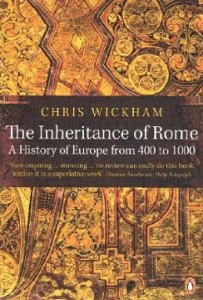 If you look back to when those first Roman dissidents left Italy in AD 395 and trekked north to found Roma Nova, you can find out quite a bit about Roman life and culture at that time. This gives you a starting point: their mindset, their customs, their concerns, their ways of doing things. For instance, the first chapters of Christopher Wickham’s book The Inheritance of Rome draws a clear and detailed picture. If you look back to when those first Roman dissidents left Italy in AD 395 and trekked north to found Roma Nova, you can find out quite a bit about Roman life and culture at that time. This gives you a starting point: their mindset, their customs, their concerns, their ways of doing things. For instance, the first chapters of Christopher Wickham’s book The Inheritance of Rome draws a clear and detailed picture.

With the Roma Nova books, I’ve used terms that people might already know like the Roman sword, gladius, greeting such as salve, solidi as money, ranks like legate and centurion. But I’ve made the gladius carbon steel, the solidi have currency notes and debit cards as well as coins, and I’ve mixed in other European military ranks such as captain. It gives a sense of history that’s gone forward and adapted to the modern age.
Ancient Romans were fabulous engineers and technologists, organised and determined to apply practical solutions to the needs of their complex and demanding civilisation, so I’ve positioned them in the 21st century at the forefront of the communications and digital revolutions.
 The silver mines and processing industry that underpinned Roma Nova’s early economy, and still play an extremely important role in 21st century Roma Nova, are another allusion to ancient Rome. Silver was a big reason the Romans wanted Britannia. Dacia (Romania) and Noricum (Austria) in central Europe were of special significance, as they were very rich in high quality deposits. The silver mines and processing industry that underpinned Roma Nova’s early economy, and still play an extremely important role in 21st century Roma Nova, are another allusion to ancient Rome. Silver was a big reason the Romans wanted Britannia. Dacia (Romania) and Noricum (Austria) in central Europe were of special significance, as they were very rich in high quality deposits.
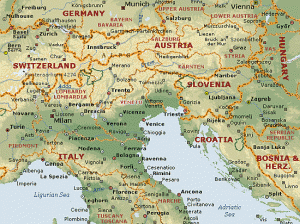 Giving Roma Nova silver deposits provides a plausible reason for its economic survival through the ages. I also needed mountains, a river, land where farmers could work vineyards, grow olives, wheat and vegetables, and raise animals. I also wanted my imaginary country to be near Italy and Austria. So it had to be in south central Europe. In the end I pinched Slovenia as my model. Giving Roma Nova silver deposits provides a plausible reason for its economic survival through the ages. I also needed mountains, a river, land where farmers could work vineyards, grow olives, wheat and vegetables, and raise animals. I also wanted my imaginary country to be near Italy and Austria. So it had to be in south central Europe. In the end I pinched Slovenia as my model.
This and the previous post give you a glimpse into the world of Roma Nova. What else would you like to know?
Updated 2018: Alison Morton is the author of Roma Nova thrillers – INCEPTIO, PERFIDITAS, SUCCESSIO, AURELIA, INSURRECTIO and RETALIO. CARINA, a novella, is available now. Audiobooks are available for the first four of the series.
Get INCEPTIO, the series starter, FREE as a thank you gift when you sign up to Alison’s monthly email newsletter. You’ll also be first to know about Roma Nova news and book progress before everybody else, and take part in giveaways.
If you enjoyed this post, do share it with your friends!Like this:Like Loading...
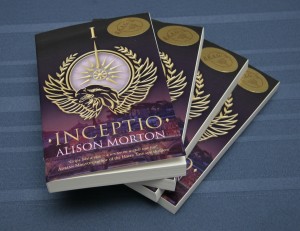 Offer 1: Two-book bundle Offer 1: Two-book bundle
A signed paperback copy of each of INCEPTIO and PERFIDITAS
UK – £18.50
Europe – 22.00€
US – US$ 29.50
All prices include postage (second class/economy) and packing. Please ask for rates to rest of world.
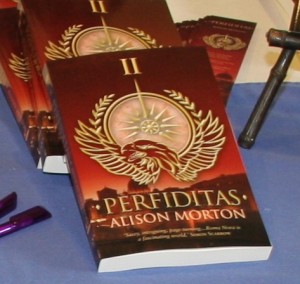 Offer 2: Individual paperback gift service Offer 2: Individual paperback gift service
A seasonal greetings card with personalised message from the author with bookmark, gift wrapped and sent to the person of the buyer’s choice: either INCEPTIO or PERFIDITAS.
UK – £13.50,
Europe – 15.00€
US – US$ 21.60
All prices include postage (second class/economy) and packing. Please ask for rates to rest of world.
Contact me at hello@alison-morton.com to order. I will send you a confirmatory email asking you for full details. Payment by PayPal/credit/debit card
It would really help if you could put “Saturnalia offer 1″ or “Saturnalia offer 2″ as appropriate in the subject header. Last date for orders 6 December. After that, I can’t guarantee you’ll receive it in time…
Io Saturnalia!
If you enjoyed this post, do share it with your friends!Like this:Like Loading...
|
Subscribe to Blog via Email
Join 50 other subscribers.
Categories
Archive
|
 She works in a ‘run of the mill’ office job, she left education after high school and doesn’t earn quite enough money to cover her bills. She’s outdoorsy – she jogs and goes to the gym. She remembers her rural childhood in leafy New Hampshire with longing and lives for the weekends working as a volunteer in the park. We know she stands up for other people – the injured man in the park, her cousin in Nebraska. Like anybody else would be, she’s frightened when Renschman and his people threaten her. But then she gets angry.
She works in a ‘run of the mill’ office job, she left education after high school and doesn’t earn quite enough money to cover her bills. She’s outdoorsy – she jogs and goes to the gym. She remembers her rural childhood in leafy New Hampshire with longing and lives for the weekends working as a volunteer in the park. We know she stands up for other people – the injured man in the park, her cousin in Nebraska. Like anybody else would be, she’s frightened when Renschman and his people threaten her. But then she gets angry. Moving and shaking
Moving and shaking In Roman fiction, wearing a simple tunic is easier than a heavy toga! Position in life, occupation, age and gender also affect whether the character walks confidently, swaggers or trudges along with head bowed as well as what a character is thinking or feeling at the time.
In Roman fiction, wearing a simple tunic is easier than a heavy toga! Position in life, occupation, age and gender also affect whether the character walks confidently, swaggers or trudges along with head bowed as well as what a character is thinking or feeling at the time.
















